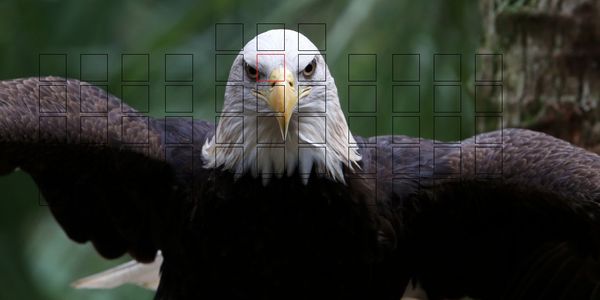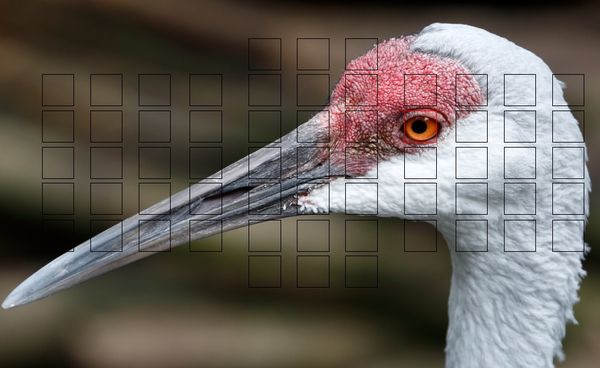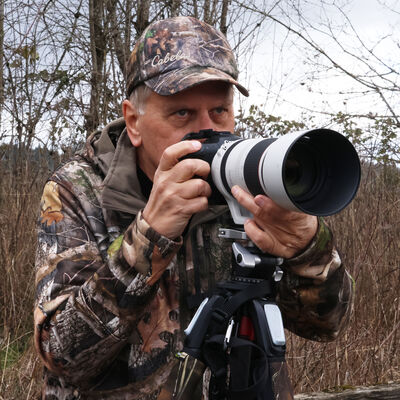Check out Astronomical Photography Forum section of our forum.
Focus ONE spot or multiple?
Apr 16, 2019 10:06:35 #
bleirer wrote:
Without getting too far off topic, I'll add the last idea that depth of field is still out of focus, just acceptably out of focus that it still looks sharp. CHG CANON's eagle pictures in the other thread look dead on plane, however you achieved that.
When your distance to the subject is far and the composition will be cropped anyway with lots of space around the subject, working with the center point and (an initially) centered composition is somewhat immaterial assuming you have your focus point on the location of critical focus, eagle screen capture.
But, when your subject fills the frame, focusing on the subject's eyes (or the image's subject) becomes critical, see sandhill crane.
Apr 16, 2019 10:45:12 #
nadelewitz
Loc: Ithaca NY
Longshadow wrote:
I use center-point only and <re->compose.
(Who knows what all those other dots are focusing on.)
(Who knows what all those other dots are focusing on.)
Precisely!
Apr 16, 2019 11:17:06 #
elliott937 wrote:
For years, in using my Canon DSLRs, I've always turned off the gazillion focusing squares and elected for just one in the center. I suppose if photographing a moving subject, moving either toward or away from the camera would be a perfect time to have the gazillion squares turned on. For me, I prefer to have just one focusing square and have total control. Am I missing something? Or, do many of you turn off all but one of the focusing squares?
95% of the time I use 1 focus point. The other 5% I turn on 9 points for birds in flight. I use back button focus and have two buttons programed. One with one focus point and the other with 9 focus points. That way I can switch fast.
Apr 16, 2019 11:49:30 #
therwol
Loc: USA
elliott937 wrote:
For years, in using my Canon DSLRs, I've always turned off the gazillion focusing squares and elected for just one in the center. I suppose if photographing a moving subject, moving either toward or away from the camera would be a perfect time to have the gazillion squares turned on. For me, I prefer to have just one focusing square and have total control. Am I missing something? Or, do many of you turn off all but one of the focusing squares?
Recomposing after using the center focus point on a subject that isn't in the center can change the plane of focus such that your subject isn't perfectly focused any longer. I usually use 3D focus tracking on my Nikon D810, and as I move the camera, the focal point stays on the subject.
Apr 16, 2019 12:11:21 #
jeryh
Loc: Oxfordshire UK
For animals and birds, I use just one focussing point, mainly for the eyes.
Apr 16, 2019 12:16:44 #
jeep_daddy wrote:
95% of the time I use 1 focus point. The other 5% I turn on 9 points for birds in flight. I use back button focus and have two buttons programed. One with one focus point and the other with 9 focus points. That way I can switch fast.
I can see where that would come in handy for birds in flight.
Apr 16, 2019 12:17:11 #
jeryh wrote:
For animals and birds, I use just one focussing point, mainly for the eyes.
Yup, the eyes have it!
Check out Landscape Photography section of our forum.
Apr 16, 2019 12:48:27 #
I prefer spot focusing - I can move the spot around with the position ring on the back to pick the spot I want in focus
Apr 16, 2019 13:02:07 #
srt101fan wrote:
I don't shoot with a tripod very often, but I assume that it would impair your ability to move the camera to get the center point on target and then move the camera again to recompose. So I assume that tripod shooters set up the camera to compose, and then move the focus point, not the camera, to allow focusing on the target, wherever that might be....
If you call it single point instead of centre point, you're there in one - with touch screen it is easy to just move the single focus point to anywhere in the frame. However - without touch screen, tilt and swivel with focus lock should do the trick.
Apr 16, 2019 13:05:17 #
Delderby wrote:
If you call it single point instead of centre point, you're there in one - with touch screen it is easy to just move the single focus point to anywhere in the frame. However - without touch screen, tilt and swivel with focus lock should do the trick.
On many cameras, including mine, "single" spot uses the center point only.
My phone has a movable focus point, but not my cameras. (No tilt, swivel, touch.)
Apr 16, 2019 13:13:11 #
For most shots I use single point focus with thumb controlled BBF continuous servo focusing mode. It is a very natural habit for me now to refocus on a subject quickly with the single point, focusing exactly where I want, then move camera slightly for composition and shoot. I also use the 3 custom programs consistently. My C3 custom setting is set more for moving subjects like BIF, so that program is set to a larger grid focusing pattern.
Check out Underwater Photography Forum section of our forum.
Apr 16, 2019 13:14:20 #
Longshadow wrote:
On many cameras, including mine, "single" spot uses the center point only.
My phone has a movable focus point, but not my cameras. (No tilt, swivel, touch.)
My phone has a movable focus point, but not my cameras. (No tilt, swivel, touch.)
?
Even the entry-level DSLRs had 7-points as of the 300D / Digital Rebel, circa 2003. The D30 had 3 AF points, similar to the film-based Rebels if the late 90s / early 00s.
Apr 16, 2019 13:23:10 #
CHG_CANON wrote:
?
Even the entry-level DSLRs had 7-points as of the 300D / Digital Rebel, circa 2003. The D30 had 3 AF points, similar to the film-based Rebels if the late 90s / early 00s.
Even the entry-level DSLRs had 7-points as of the 300D / Digital Rebel, circa 2003. The D30 had 3 AF points, similar to the film-based Rebels if the late 90s / early 00s.
Been so long since I set it (almost 9 years), maybe I can set any one point? Center seemed most logical......
Apr 16, 2019 13:52:12 #
amfoto1
Loc: San Jose, Calif. USA
elliott937 wrote:
For years, in using my Canon DSLRs, I've always turned off the gazillion focusing squares and elected for just one in the center. I suppose if photographing a moving subject, moving either toward or away from the camera would be a perfect time to have the gazillion squares turned on. For me, I prefer to have just one focusing square and have total control. Am I missing something? Or, do many of you turn off all but one of the focusing squares?
I use single point the majority of the time. The advantage to it is that you control exactly where the camera and lens focus.
However, sometimes with faster and more erratically moving subjects it's necessary to use a multi-point method of focusing. The disadvantage to this is that it leaves it up to the camera to decide where to focus and there's some risk that it won't be precisely where you'd prefer it to do so. You have to weigh this risk against the difficulty keeping a single point on the moving subject. And there are other factors... For example, if you are using a smaller lens aperture you can tolerate some slightly missed focus and may be more able to use a multi-point method.
Some cameras have choice of multi-point focus "patterns" too... Such as Zone Focus or Expansion Points. These limit the number of points the camera can opt to use and can reduce risk of missed focus to some extent, when used properly. The difference between them are that Zone allows the camera to start focusing using any of the active AF points, while Expansion leaves it to the photographer to choose a single point where AF will start, but allows the camera to switch to an adjacent point if "needed" because the starting point isn't kept on the subject by the photographer.
The Zone patterns and All Points will usually start focusing on whatever is closest to the photographer and covered by one (or more) of the active AF points. For example, if you are tracking a large bird flying past, the camera is likely to focus on the closest wing tip, rather than on the bird's head and body.
Depending upon camera model, there are may be two different sizes of Zones available (in addition there's "All Point/Auto Selection"... which in effect is one great big Zone too). Also depending upon the camera model, there may be multiple Expansion patterns available: 4-point and 8-point. The difference is that 4-point allows the points directly above and below, left and right of the starting point to be used. 8-point allows those plus the diagonally located points.... all 8 points surrounding the starting point... to be used, if needed. When I use multiple points, I usually use Expansion instead of Zone... and with either of those I generally use the smallest pattern that will do the job.
But, for me those are all "specialty" focus modes that I use in certain circumstances. I tend to use Single Point the vast majority of the time. I prefer it, whenever possible, even though it's more work for me keeping the AF point right on the subject. (Note: I also use Back Button Focusing almost exclusively, along with AI Servo mode... Most of what I shoot is action/sports/wildlife).
I also tend to use the center point the most. Yes, this ends up centering subjects in the image quite often. To have option to position subjects off-center, I try to compose my images slightly loosely, to allow a little cropping if needed. Emphasis on "slightly" here... I still try to "fill the viewfinder" as much as possible too, in order to avoid over-cropping.
BTW, Canon pioneered multi-point AF... I think the EOS 10/10S cameras of 1990 were the first, with 3-point AF. In 1992 the EOS A2/A2E upped that to 5-point AF and the "E" version also had "Eye Control", which is supposed to detect the users eye movement to know where they are looking and switch AF points automatically. The premium/pro EOS 1N (1994) also had 5-point AF, but without Eye Control.
The EOS-3 (1998) introduced 45-point AF with Eye Control, while the EOS-1V (2000) was intro'd with similar 45-point AF without Eye Control. The 45-point system (without Eye Control) continued to be used in the 1D and 1Ds-series pro cameras for a number of years... Eventually replaced with the 61-point AF used in the 1DX and later 5D-series models today.
In 2000 the EOS 33/Elan 7, EOS 30/Elan 7E 30E models introduced 7-point AF The EOS 30/Elan 7E had "Eye Control", while the EOS 33/Elan 7 didn't.
Later "V" and "N" versions of the EOS 33/30, Elan 7/7E models intro'd in 2004 were minor upgrades... and among the very last film SLRs Canon introduced. (Later the same year, the Rebel T2/EOS 100X was the last model intro'd. The EOS-1V was the last film SLR to remain in production... until May 2018.)
Apr 16, 2019 13:56:46 #
As the ‘gazillion squares’ are used for Auto focussing why would you expect them to work when you are Manual Focussing?
If you want to reply, then register here. Registration is free and your account is created instantly, so you can post right away.
Check out Black and White Photography section of our forum.






